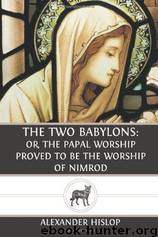The Two Babylons: Or, the Papal Worship Proved to Be the Worship of Nimrod and His Wife

Author:Alexander Hislop [Hislop, Alexander]
Language: eng
Format: epub
Tags: Spirituality, Papal, Catholic, Pope, Nimrod, Pagan
ISBN: 9781489555816
Google: z8WNnQEACAAJ
Amazon: 1492287261
Publisher: CreateSpace Independent Publishing Platform
Published: 2013-05-24T22:00:00+00:00
Section III. The Sacrifice of the Mass
If baptismal regeneration, the initiating ordinance of Rome, and justification by works, be both Chaldean, the principle embodied in the "unbloody sacrifice" of the mass is not less so. We have evidence that goes to show the Babylonian origin of the idea of that "unbloody sacrifice" very distinctly. From Tacitus we learn that no blood was allowed to be offered on the altars of Paphian Venus. Victims were used for the purposes of the Haruspex, that presages of the issues of events might be drawn from the inspection of the entrails of these victims; but the altars of the Paphian goddess were required to be kept pure from blood. Tacitus shows that the Haruspex of the temple of the Paphian Venus was brought from Cilicia, for his knowledge of her rites, that they might be duly performed according to the supposed will of the goddess, the Cilicians having peculiar knowledge of her rites. Now, Tarsus, the capital of Cilicia, was built by Sennacerib, the Assyrian king, in express imitation of Babylon. Its religion would naturally correspond; and when we find "unbloody sacrifice" in Cyprus, whose priest came from Cilicia, that, in the circumstances, is itself a strong presumption that the "unbloody sacrifice" came to it through Cilicia from Babylon. This presumption is greatly strengthened when we find from Herodotus that the peculiar and abominable institution of Babylon in prostituting virgins in honour of Mylitta, was observed also in Cyprus in honour of Venus. But the positive testimony of Pausanias brings this presumption to a certainty. "Near this," says that historian, speaking of the temple of Vulcan at Athens, "is the temple of Celestial Venus, who was first worshipped by the Assyrians, and after these by the Paphians in Cyprus, and the Phoenicians who inhabited the city of Ascalon in Palestine. But the Cythereans venerated this goddess in consequence of learning her sacred rites from the Phoenicians." The Assyrian Venus, then--that is, the great goddess of Babylon--and the Cyprian Venus were one and the same, and consequently the "bloodless" altars of the Paphian goddess show the character of the worship peculiar to the Babylonian goddess, from whom she was derived. In this respect the goddess-queen of Chaldea differed from her son, who was worshipped in her arms. He was, as we have seen, represented as delighting in blood. But she, as the mother of grace and mercy, as the celestial "Dove," as "the hope of the whole world," (BRYANT) was averse to blood, and was represented in a benign and gentle character. Accordingly, in Babylon she bore the name of Mylitta--that is, "The Mediatrix." *
* Mylitta is the same as Melitta, the feminine of Melitz, "a mediator," which in Chaldee becomes Melitt. Melitz is the word used in Job 33:23, 24: "If there be a messenger with him, an interpreter (Heb. Melitz, "a mediator"), one among a thousand, to show unto man his uprightness, then he is gracious unto him, and saith, Deliver him from going down to the pit; I have found a ransom.
Download
This site does not store any files on its server. We only index and link to content provided by other sites. Please contact the content providers to delete copyright contents if any and email us, we'll remove relevant links or contents immediately.
| New Testament | Old Testament |
The Five People You Meet in Heaven by Mitch Albom(2861)
Name Book, The: Over 10,000 Names--Their Meanings, Origins, and Spiritual Significance by Astoria Dorothy(2505)
Real Sex by Lauren F. Winner(2498)
The Holy Spirit by Billy Graham(2445)
The Secret Power of Speaking God's Word by Joyce Meyer(2268)
How The Mind Works by Steven Pinker(2242)
0041152001443424520 .pdf by Unknown(2241)
ESV Study Bible by Crossway(2191)
Ancient Worlds by Michael Scott(2121)
The Meaning of the Library by unknow(2082)
The Gnostic Gospels by Pagels Elaine(2048)
Churchill by Paul Johnson(2025)
The ESV Study Bible by Crossway Bibles(2005)
MOSES THE EGYPTIAN by Jan Assmann(1985)
Jesus by Paul Johnson(1902)
Ancient Near Eastern Thought and the Old Testament by John H. Walton(1861)
The Nativity by Geza Vermes(1859)
The Complete Dead Sea Scrolls in English (7th Edition) (Penguin Classics) by Geza Vermes(1856)
City of Stairs by Robert Jackson Bennett(1851)
